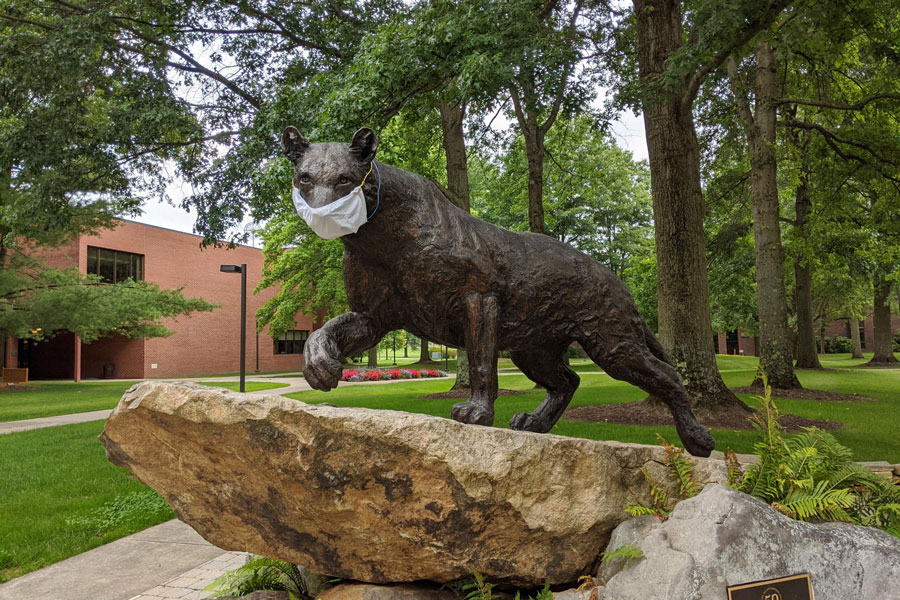Students report to campus Thursday
New safety procedures initiated throughout university

University of Pittsburgh at Bradford students will return this week to a much different campus than the one they left in March.
For the past several months, faculty, staff and administrators have been planning and reconfiguring nearly every facet of University life.
In order to mitigate the spread of COVID-19, the University has rearranged space and schedules to allow for physical distancing, required students to spend two weeks “sheltering in place,” and arranged for testing protocols, isolation and quarantine.
“It is simply remarkable the energy and ingenuity that Pitt-Bradford faculty and staff have brought to this challenge,” said Dr. Catherine Koverola, president of Pitt-Bradford. “We are confident that with physical distancing, face coverings and diligent hand hygiene, we have minimized the risk to our students, faculty, staff and neighbors in the surrounding community.”
“During all of our planning, we have followed the guidance from the University of Pittsburgh’s Healthcare Advisory Group, which includes world-renowned experts in the health sciences and public health fields.”
Through a new flexible academic course delivery system, students had the option to move to an entirely online model for remote learning, and so far, about 210 of the university’s 1,300 students chose this option. Other students will attend using a hybrid model – having some classes in person, others online. This flexible model also enables faculty who are unable to be on campus to deliver their courses remotely.
In order to create adequate room for physical distancing, some classes are being moved to larger spaces on campus, such as the Mukaiyama University Room in the Frame-Westerberg Commons, the Bromeley Family Theater in Blaisdell Hall and even the Ken Jadlowiec Fitness Center. Fitness center equipment has been moved to the McDowell Fieldhouse to enable students to practice physical distancing while working out.
To further the general de-densification of campus, some five-person residence hall suites were reduced to three-person suites, meals will be served to-go in compostable disposable containers, and many staff will continue to work from home.
Staff installed new technology in many spaces to create classroom experiences and added features such as drop-down microphones to help students attending online hear the discussion of their in-class classmates.
First-year students arrive Thursday for the first day of a three-day move-in period. Students selected specific arrival times to ensure that only a couple dozen people would be moving into a building at a time. After all students have moved in, representatives from Pitt will conduct surveillance COVID-19 testing of 10 percent of the student body to determine the prevalence of COVID-19 on campus. Pitt’s COVID-19 Medical Response Office selected the 10 percent number after consulting with epidemiologists and statisticians.
The COVID-19 Medical Response Office, led by expert faculty from Pitt’s School of Medicine, has worked closely with Bradford campus staff to establish protocols for students to “shelter in place” for a week before and after they move to campus. During this time, students stay in their homes and limit contacts in order to lower the risk of exposure to the virus, which has an incubation period of up to two weeks.
The office also helped the Bradford campus ensure protocols for testing students with symptoms.
Students suspected of having or testing positive for COVID-19 will be moved into an isolated housing unit, where they will communicate by phone or email daily with health services staff. They also will be contacted by a contact tracer. Other members of the affected student’s “pod” (suite or hallway) will quarantine in place with food delivered.
To emphasize the importance of adhering to health and safety measures such as wearing face coverings and maintaining physical distancing, all students, faculty and staff who return to campus will complete an acknowledgment of a community compact, which includes health and safety guidelines, both on campus and off. Violations of these health and safety measures will be enforceable under a newly revised student code of conduct.
For more information on Pitt-Bradford’s COVID-19 health and safety measures, visit www.upb.pitt.edu/operating-safely-fall.
--30--